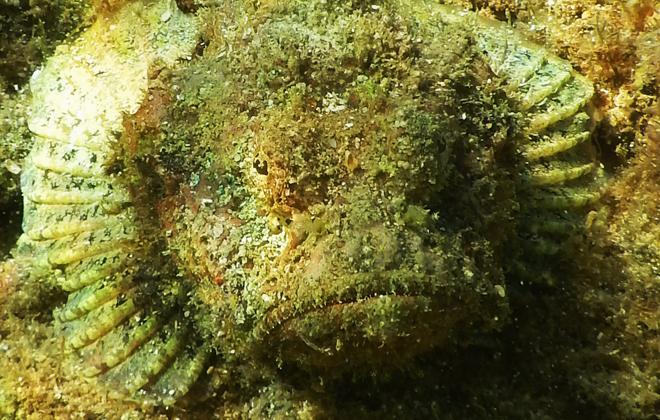Published in the Ocean Watch column, Honolulu Star-Advertiser © Susan Scott
April 20, 2015
The trouble with taking pictures of scorpionfish, called nohu in Hawaiian, is that I often delete the photos thinking I missed whatever fish I was trying to shoot. Then later I wonder what happened to my scorpionfish pictures and find them in the recycle bin.
Not this time. While snorkeling recently, I found a devil scorpionfish sitting right out in the open, exceptionally noticeable in all its bumpy beauty. When I drew close to snap photos, the 12-inch-long fish held its ground. Go ahead, those bulging eyes seemed to say as the fish fanned out its scalloped side fins. Touch me. See what happens.
 A scorpionfish matches its surroundings well. ©2015 Susan Scott
A scorpionfish matches its surroundings well. ©2015 Susan Scott
I knew what would happen. Scorpionfish belong to a large family of fish that get their name from venomous fin spines.
Some scorpionfish match their surroundings so well that they’re hard to spot even when right in front of your face. These types grow algae and fleshy flaps on their skin for camouflage. When this invisibility cloak gets overly fuzzy, the fish molts and starts over.
Other scorpionfish family members, lion fish and turkey fish, use the opposite defense strategy. Their flamboyant colors and conspicuous fins are like big guns warning would-be predators to back off or be sorry.
The two diverse scorpionfish forms are clues to these fishes’ hunting methods. The camouflaged species are ambush predators, lying as motionless as the rocks they mimic while waiting for passing prey. With a lightning-speed lunge, the scorpionfish swallows the unsuspecting fish or invertebrate whole.
Lion fish and turkey fish use their delicate-looking fins to wave sand and debris off creatures on the ocean floor. The fanlike fins also trap prey in corners and against walls of coral and rocky reefs.
The most notorious of all stinging fish are the South Pacific’s stonefishes, but those species belong to a different family not found in Hawaii. Although stings from stonefish cause the rare death, fatalities usually occur in people who have other medical conditions. When supported in modern medical facilities, most people with stonefish stings survive.
Hawaii’s scorpionfish stings won’t kill you, but they hurt like the devil. Immersing the wound in hot water often relieves the pain.
Scorpionfish use their venomous spines for defense only. Leave them alone and they’ll return the favor.
I took several pictures of the little limestone impersonator and back home immediately downloaded my memory card. Even so, when organizing pictures recently, I wondered what I was thinking to have saved a photo file of rocks.